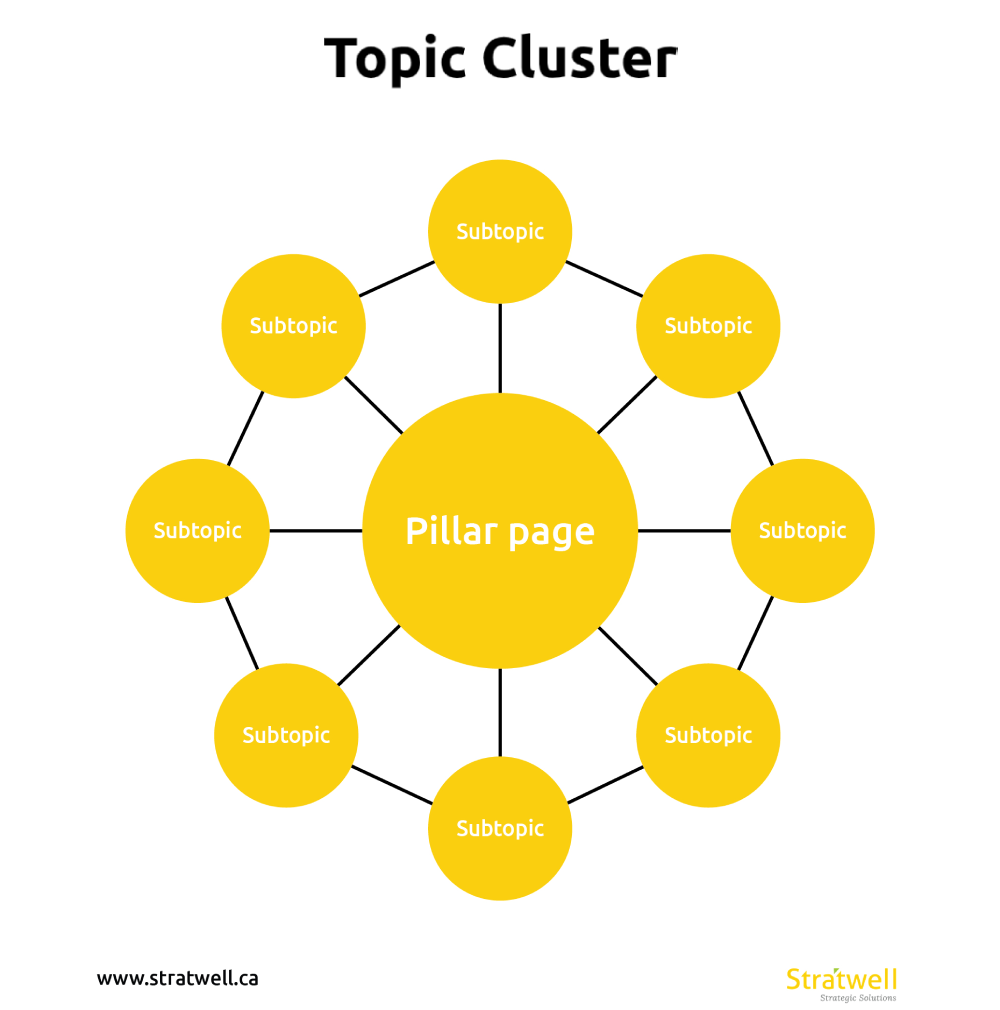In 2013, Google released an update to its search algorithm called the Hummingbird update. It’s widely believed that the update was a response to customers’ changing behaviors and Google’s continued efforts to providing a better overall search experience to its users. As a result, Google, by far the most dominant search engine, began to switch to a more topic focus rather than the traditional keywords focus search results.
What did the change mean for SEO?
It effectively signalled what many have referred to as “the next revolution for SEO.” Google began with interpreting phrases and understanding semantic search with the launch of the Hummingbird update. In 2015, Google released the RankBrain update that included its machine learning algorithm that sought to understand the context of users’ queries and not just the exact-match keywords.
Digital marketers were, in effect, compelled to cluster content and have more interlinking so as to improve their rankings. Using topic clusters and pillar pages has now been proven to significantly improve rankings on SERPs.
What are Topic Clusters and Pillar Pages?
Topic clusters and pillar pages aren’t just passing fads in the SEO world. They are both crucial elements of the ever-evolving SEO, especially since Google has shifted its focus to machine learning which now helps it deliver better search results based on users’ natural languages, synonyms, or abstract concepts.
A topic cluster is method of grouping all your content into clusters. You simply have one core topic (pillar page) and then have multiple subtopics, all linking to the core topic.
A pillar page is a long-form article or content page that broadly covers all aspects of a specific topic. It’s rich and loaded with information on that topic, more like a ‘topic 101’ that touches on every important aspect of the subject in question.
Why You Should Consider the Topic Clusters Strategy
Topic clusters provide more details about the subtopics contained in a pillar page. Therefore, the topic cluster strategy is a great way to organize your content. The cluster content pages weave into the umbrella topic (pillar) by allowing you to use long-tail keywords associated with the main topic.
But perhaps the greatest benefit of topic clusters is the overall effect it will have on your rankings. If one of your content pages performs well in SERP, the entire cluster will also gain considerable traffic.
Keep in mind that you are creating content for your audience and not search engines. By adding long tail keywords to support and link back to the pillar post, you will be generating traffic from the various questions your readers may have on that specific topic, which in turn benefits for the entire cluster content.
How to Identify Topic Clusters
The starting point is always the overarching topic or what your business is all about. Depending on how wide your area of focus may be, you may want to break it down into several pillars.
Here’s a step-by-step guide on how you can start creating topic clusters:
Step 1: single out 5-10 core problems that your audience may be facing. You can use both primary sources (surveys, interviews, etc.) or secondary sources (online community chat groups, online research, etc.).
Step 2: group all the problem areas into broad topic areas and cover each of the topic areas in detail. While creating blog posts, focus on niche and long tail keywords that have minimal competition for ranking. The idea is to focus on relevant topics and quality content that will keep your audience on your website for long rather than trying to simply compete for keywords.
Step 3: Create a page for your pillar topic and exhaustively cover every aspect of the topic. Add links to the specific content pages that cover the subtopics in great detail.
How to Create Pillar Pages
Google now has a more in-depth understanding of the intent behind a user’s search query. Therefore, SERPs now prioritize websites that have more credible and relevant information rather than the ones that try to rank for keywords based on exact-type.
A pillar page is the central hub upon which a topic cluster is built and the starting point for topic authority. While keywords still play into your overall content marketing strategy, they should no longer be the focus. The key is to start building on topics. You pillar page should answer almost every question your audience is likely to have based on a particular keyword they may be searching for.
Note that a blog post covering a specific topic in great detail does not constitute a pillar page. Rather, it can become a pillar post if it covers as many aspects of a specific topic as possible. Remember, the idea of a pillar post is to “own” a specific topic.
To read about how to create relevant blog post to help drive your business, check out our article here.
Promote and Maintain Your Pillar Posts
Ideally, the perfect pillar page should be everything your audience needs and nothing they don’t need. Therefore, you will have to move away from your old tactics of how you put together your content (focusing on keywords, etc.) to a more topic-focused approach.
An important question to ask yourself is whether your pillar page directly answers a user’s search query. Would your pillar post be enticing enough for them to visit your website for more information?
Therefore, your pillar posts will require several tweaks and a bit more fine-tuning. You will also need to verify that all the links, both internal and external, actually work.
One way to ensure great results is to include a pillar campaign in your overall content strategy. Such a campaign would follow a logical, 3-step process: planning, creating the content, and promotion.
Promoting your pillar posts is perhaps the most crucial part of the campaign. You could monitor the performance of your pillar posts so that you can constantly optimize both the content and promotion scheduling for better results.
Other options to promote and maintain your pillar posts include;
- Using social monitoring tools (for brand and keyword monitoring)
- Adding your pillar post links to social bookmarking sites
- Responding to questions on social Q&A websites (Quora, Yahoo Answers, etc.)
- Promoting on social media channels
- Using influencers
Remember, setting up a pillar page isn’t just a one-off activity. To increase and maintain traffic to your website, you’ll have to keep promoting the pillar page so that you can sustain the interest around the topic for your intended audience.
To read about our 5-steps guide on how to create a pillar page, please click here.
If you would like to learn more about how to build links to your website and establish authority on search engines, please check out our blog post here.
Conclusion
If you are not already using content pillars and clusters, they can breathe a new lease of life into your content and revamp your overall content strategy. Pillar pages and topic clusters help to build trust and authority on particular topics. This, rather than competing for keywords, will significantly improve your SEO rankings.
If you would like to read on about how to create a comprehensive content marketing strategy or the history and future revolution of SEO, please check out our blog posts.
What is the content marketing strategy you are currently using? Have you tried the pillar post and topic cluster model to build out your content? Comment below and let us know!
Enjoy this article? Subscribe to get similar articles delivered to your inbox and don’t forget to share it with your friends.
Other Related Blog Posts:
Alan Lo, Managing Partner of Stratwell Strategic Solutions, brings a decade of entrepreneurial and business development experience. Early in his career he was instrumental in building out the distribution channels of a real estate investment firm with over $2 billion in AUM. He has then founded an investment company in 2014 which he successfully exited in 2019.













2 Comments
This really explained the concept well. Thank you!
Thank you for the feedback, Terrence!